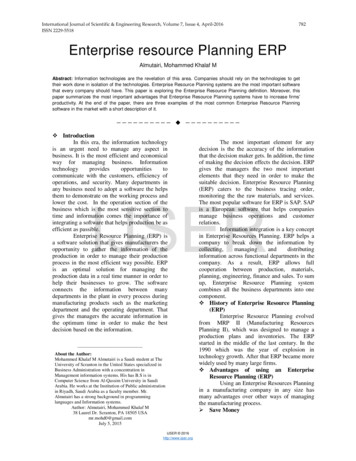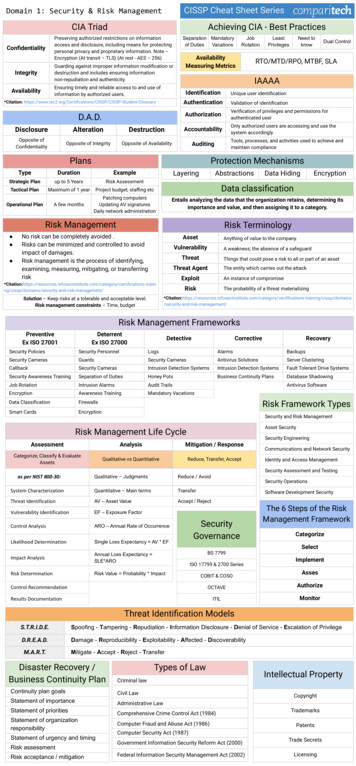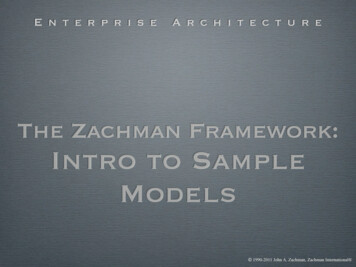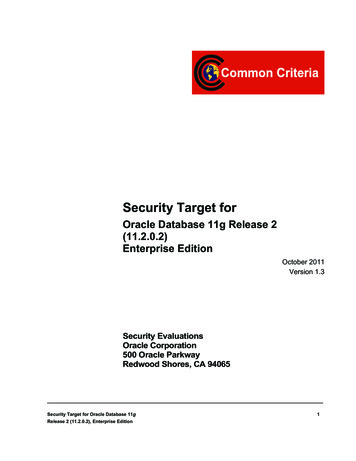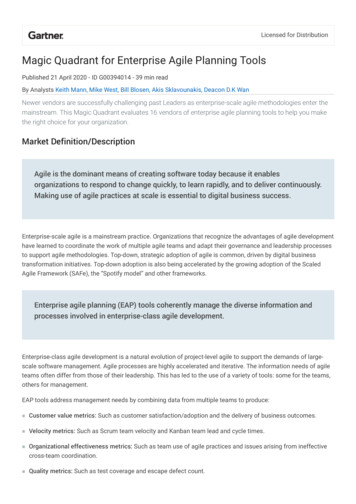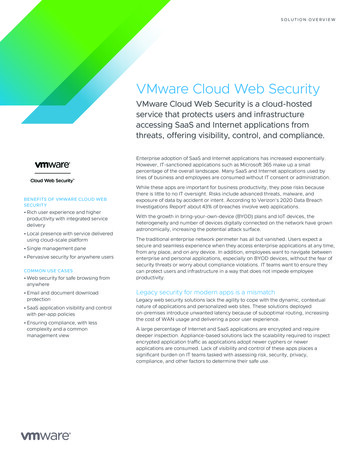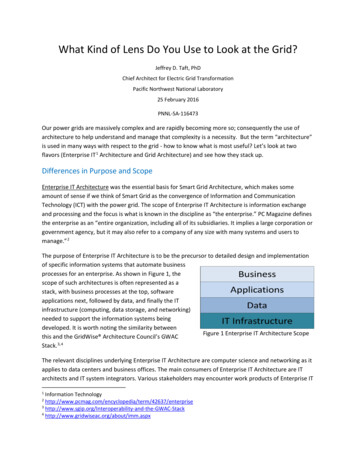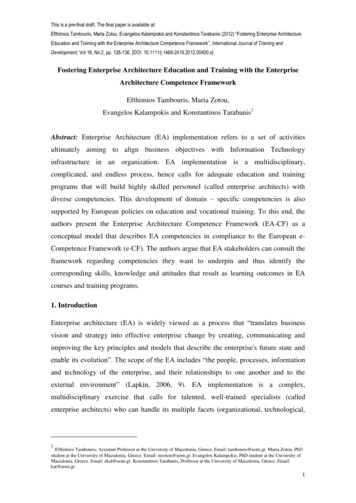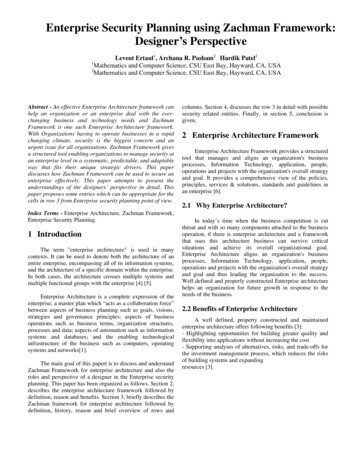
Transcription
Enterprise Security Planning using Zachman Framework:Designer’s PerspectiveLevent Ertaul1, Archana R. Pasham2 , Hardik Patel2Mathematics and Computer Science, CSU East Bay, Hayward, CA, USA2Mathematics and Computer Science, CSU East Bay, Hayward, CA, USA1Abstract - An effective Enterprise Architecture framework canhelp an organization or an enterprise deal with the everchanging business and technology needs and ZachmanFramework is one such Enterprise Architecture framework.With Organizations having to operate businesses in a rapidchanging climate, security is the biggest concern and anurgent issue for all organisations. Zachman Framework givesa structured tool enabling organizations to manage security atan enterprise level in a systematic, predictable, and adaptableway that fits their unique strategic drivers. This paperdiscusses how Zachman Framework can be used to secure anenterprise effectively. This paper attempts to present theunderstandings of the designers’ perspective in detail. Thispaper proposes some entries which can be appropriate for thecells in row 3 from Enterprise security planning point of view.Index Terms - Enterprise Architecture, Zachman Framework,Enterprise Security Planning.1 IntroductionThe term "enterprise architecture" is used in manycontexts. It can be used to denote both the architecture of anentire enterprise, encompassing all of its information systems,and the architecture of a specific domain within the enterprise.In both cases, the architecture crosses multiple systems andmultiple functional groups with the enterprise [4] [5].Enterprise Architecture is a complete expression of theenterprise; a master plan which “acts as a collaboration force”between aspects of business planning such as goals, visions,strategies and governance principles; aspects of businessoperations such as business terms, organization structures,processes and data; aspects of automation such as informationsystems and databases; and the enabling technologicalinfrastructure of the business such as computers, operatingsystems and networks[1].The main goal of this papert is to discuss and understandZachman Framework for enterprise architecture and also theroles and perspective of a designer in the Enterprise securityplanning. This paper has been organized as follows. Section 2,describes the enterprise architecture framework followed bydefinition, reason and benefits. Section 3, briefly describes theZachman framework for enterprise architecture followed bydefinition, history, reason and brief overview of rows andcolumns. Section 4, discusses the row 3 in detail with possiblesecurity related entities. Finally, in section 5, conclusion isgiven.2 Enterprise Architecture FrameworkEnterprise Architecture Framework provides a structuredtool that manages and aligns an organization's businessprocesses, Information Technology, application, people,operations and projects with the organization's overall strategyand goal. It provides a comprehensive view of the policies,principles, services & solutions, standards and guidelines inan enterprise [6].2.1 Why Enterprise Architecture?In today’s time when the business competition is cutthroat and with so many components attached to the businessoperation, if there is enterprise architecture and a frameworkthat uses this architecture business can survive criticalsituations and achieve its overall organizational goal.Enterprise Architecture aligns an organization's businessprocesses, Information Technology, application, people,operations and projects with the organization's overall strategyand goal and thus leading the organization to the success.Well defined and properly constructed Enterprise architecturehelps an organization for future growth in response to theneeds of the business.2.2 Benefits of Enterprise ArchitectureA well defined, property constructed and maintainedenterprise architecture offers following benefits [3]:- Highlighting opportunities for building greater quality andflexibility into applications without increasing the cost- Supporting analyses of alternatives, risks, and trade-offs forthe investment management process, which reduces the risksof building systems and expandingresources [3].
3 Zachman Framework for EnterpriseArchitecture3.1 DefinitionThe Zachman Framework is a schema - theintersection between two historical classifications that havebeen in use for literally thousands of years. The first is thefundamentals of communication found in the primitiveinterrogatives: What, How, When, Who, Where, and Why[8][14]. It is the integration of answers to these questions thatenables the comprehensive, composite description of complexideas. The Zachman Framework is not a methodology forcreating the implementation (an instantiation) of the object.The Zachman Framework is the ontology for describing theEnterprise [8].3.2 Zachman Framework EvolutionsHistory of Zachman Framework dates back to 1984 (seeFig 1). Since the time of the inception to today’s time, therehave been no change in the basic concepts of the frameworkbut the basic changes that can be seen over the years arerelated to the graphical representation.Source: www.zachmaninternational.comFigure 1- Zachman Framework in 19841984: Figure 1 above shows the Zachman Framework in1984, an original drawing where it has just 3 columns and itwas named as “Information System Architecture”. JohnZachman had an idea of framework of 6 columns but hepresented only 3 column framework because at that timepeople did not know much about Enterprise [14].Source: www.zachmaninternational.comFigure 2- Zachman Framework in 19871987: Figure 2 above shows the Zachman Framework in1987. The original Framework for Information SystemsArchitecture. This is the original version published in the1987 IBM Systems Journal. Notice that only the first 3Columns made it in spite of all 6 existing [14].Source: www.zachmaninternational.comFigure 3- Zachman Framework in 19921992: Still called A Framework for Information SystemsArchitecture in this 1992 IBM Systems Journal article. Fromabove Fig 3, Note that John added the words "Owner,""Designer," and "Builder"to Rows 2, 3 and 4 for clarification [14].
Source: www.zachmaninternational.comFigure 4- Zachman Framework in 19931993: It was at this point that John decided to officially callThe Zachman Framework : Enterprise Architecture - aFramework. This version is still a minor carry-over from the1987 article since it is only 3 columns. Notice from figure 4above, that in this version is the first to use the adjectives"Contextual," "Conceptual," "Logical," "Physical" and "Outof Context" defining the Rows [14].Source: www.zachmaninternational.comFigure 6- Zachman Framework in 20022002: As shown in Fig. 6, one significant improvement in thisversion however, is the use of the black to white gradientbetween the cells - which works its way down the columns.The movement down each column has nothing to do withgranularity; it has everything to do with transformation [14].Source:www.zachmaninternational.comFigure 7- Zachman Framework in 2003Source: www.zachmaninternational.comFigure 5- Zachman Framework in 20012001: During this time, Enterprise Architecture was reallygaining ground based on John's thoughts about the subject.Fully recognized as The Zachman Framework , this versionwas very widely distributed and had many of the refinementsfrom the previous 10 years of research (See Fig 5) [14].2003: This Framework (see Fig 7) does have some significantshortcomings. In addition, the colors of Rows 2 and 3 becameinverted. Because of the colors of each Row, this Frameworkillustration emphasizes the Rows. [14].
3.3 Why Zachman FrameworkWith the use of Zachman Framework the costs aredecreased, revenues are increased, processes are improved andbusiness opportunities are expanded.Closer partnership between business and IT groups.Consistently proven itself [14][8]. It helps an organizationachieve its business strategy; it gives the organization fastertime to market for new innovations and capabilities [16].3.4 Rules of Zachman FrameworkSource: www.zachmaninternational.comFigure 8- Zachman Framework in 20042004: After significant research starting in 2001, this copy ofThe Zachman Framework , also known as The ZachmanFramework2 , was developed in 2004 and is fairlyrecognizable (see Fig 8) [14].Rule 1: Columns have no order [17].Rule 2: Each column has a simple, basic model [17].Rule 3: Basic model of each column is unique [17].Rule 4: Each row represents a distinct view [17].Rule 5: Each cell is unique [17].Rule 6: Combining the cells in one row forms a completedescription from that view [17].Rule 7: Do not Create Diagonal Relationships between Cells[17].3.5Zachman Framework Rows OverviewRow 1 – Scope - External Requirements & Definition of theEnterpriseRow 2 – Enterprise Model - Business Process Modeling andFunction AllocationRow 3 – System Model - Logical Models RequirementsDefinitionRow 4 – Technology Model - Physical Models SolutionDefinition and DevelopmentRow 5 – As Built - As Built DeploymentRow 6 – Functioning Enterprise - Functioning EnterpriseEvaluationSource: www.zachmaninternational.comFigure 9- Zachman Framework in 20082008: Figure 9 is the most current evolution of The ZachmanFramework developed and is the version handed out toanyone who attends the Complete MasterClass in theZachman Certified – Enterprise Architect program, whichmakes this representation a bit of a collector's item because ofit's limited availability through the Zachman Courses [14].Figure 10- Rows of Zachman Framework
3.6ZachmanOverviewFrameworkColumnsThe basic model of each column is uniquely defined, yetrelated across and down the matrix. In addition, the sixcategories of enterprise architecture components, and theunderlying interrogatives that they answer, form the columnsof the Zachman Framework. Figure 11 shows clearly thedescription of each column.Verification ensures that the specification is complete and thatmistakes have not been made in implementing the model [15].Data Workflow Model: A workflow consists of a sequenceof connected steps. Workflow may be seen as any abstractionof real work, segregated in work share, work split or othertypes of ordering.Figure 11- Columns of Zachman Framework4 Designers Role (Row 3) – In DetailDesigner is responsible for designing a part of thesystem, within the constraints of the requirements,architecture, and development process for the project. Thisrow was originally called “information system designer’sview” in the original version of the ZF (see Fig. 10) [18]. Thefunctionality of this fully attributed model is to reflect theenterprise model of the above (owner) row [2].Who is a designer? The system analyst (Designer) representsthe business in a disciplined form. Due to the increase in thenumber of users and complex IT environment, installing afirewall can no longer be the solution of security measures.Therefore, in this row the Designer hardens the applicationsand the operating system of the enterprise to ensure reliablesecurity operations [18] [2].Figure 13- Entities of Zachman Framework Row 3/ Column 1Data Relationship Model: Relationships are the logicalconnections between two or more entities .E-R (entityrelationship) Diagrams are used to represent Data relationshipModels.Data Backup Model: Data recovery is required because ofthe following reasons: Disaster recovery, virus protection,hardware failure, application error and user errors.Identity-Theft Model: Identity theft is the wrongful use ofanother person’s identifying information—such as credit card,social security or driver’s license numbers—to commitfinancial or other crimes.Data Privacy Model: The main challenge in data privacy isto share some data while protecting personal information. Thisprivacy policy model combines user consent, obligations, anddistributed administration [12].Figure 12- Row 3 of Zachman Framework4.1 Row3/Column 1 : Data/WhatThe first cell of Row 3 represents the logical data model,which describes the systems view of interest by transformingthe real description of the product into its built inspecifications. All the entries from owner go throughvalidation over here. Figure 13 shows the possible entities oflogical system model [2]:Data Verification Model: Data Verification is a processwherein the data is checked for accuracy and inconsistencies.Data Security Model: Data security is the practice of keepingdata protected from corruption and unauthorized access. Thefocus behind data security is to ensure privacy whileprotecting personal or corporate data [12].4.2 Row3/Column 2 : Function/HowThe second cell of Row 3, application architecture,discusses the information security policy function ofenterprises which needs to mandate the backups of all dataavailable at all times. The major things under considerationare the overall security of the data including the assurance ofno data loss. Figure 14 shows the possible entities ofapplication architecture.
Disaster Recovery Process: Figure 15 shows the keyelements of disaster recovery planning process. A disasterrecovery plan covers both the hardware and software requiredto run critical business applications and the associatedprocesses to transition smoothly in the event of a natural orhuman caused disaster [11].4.3 Row3/Column 3 : Network/ WhereThe third cell of Row 3, Distributed System Architecturedefines the geographical boundaries and specification of theenterprise. The possible entries of this cell are as follows:Physical Security: Physical security describes both measuresthat prevent or deter attackers from accessing a facility,resource, or information stored on physical media andguidance on how to design structures to resist various hostileacts[11].Link Security: The types of links that fall under thiscategory are Internet, Satellite Internet, Wireless and VPN.Figure 14- Entities of Zachman Framework Row 3/ Column 2End to End Security: End-to-end security relies on protocolsand mechanisms that are implemented exclusively on theendpoints of a connection. End-to-End refers to hostsidentified by IP (internet protocol) addresses and, in the caseof TCP (transmission control protocol) connections, portnumbers [12].Logistic security: Logistics is the science of planning andimplementing the acquisition and use of the resourcesnecessary to sustain the operation of a system.4.4 Row3/Column 4: People/ WhoThe fourth cell of Row 3, Human Interface Architecturedefines all the roles of the Individuals which are involved intothe Enterprise. Figure 16 below lists all the possible entities[2].Figure 15- Disaster Recovery Planning ProcessAccess Control Planning: Access Control is any mechanismby which an authority grants the right to access some data, orperform some action. Access control systems provide theessentialservicesof identification,authentication (I&A), authorization, and accountability [19].Data Archiving: Data archiving is the process of moving datathat is no longer actively used to a separate data storagedevice for long-term retention.Confidentiality, Integrity & Availability: Confidentialityrefers to limiting information access and disclosure toauthorized users -- "the right people" -- and preventing accessby or disclosure to unauthorized ones -- "the wrong people."Integrity refers to the trustworthiness of informationresources. Availability refers, unsurprisingly, to theavailability of information resources [20].Internal and External Processes: This process is to defineand control the value contribution of enterprise architectureand to integrate enterprise architecture into business.Figure 16- Entities of Row 3/ Column 44.5 Row3/Column 5: Time / WhenThe fifth cell of Row 3, Processing Structure will defineall the Timeline, Milestones, and Dependencies and otherthings for the Enterprise.
4.6 Row3/Column 6: Constraints/ WhyThe sixth cell of Row 3 is a Business Rule Model. Figure17 below lists the possible constraints for row 3.Figure 17- Entities of Row 3/ Column 65 ConclusionIn this paper, Row 3 of Zachman framework (System model)helps organizations to standardize and control the processesthat have a great impact upon both technical and non-technicaldepartments. During the course of exploring Zachmanframework we realized that though the logical concepts of thisframework gives a look and feel of simplicity, it is far beyondthat just that. For the effective application of ZachmanFramework, We learnt that viewpoint of each player should beclearly defined and well structured. Zachman framework ishelpful to achieve a better and stable design for later stage ofdevelopment specially in situations where important changesare necessary and modifications are performed regularly. It isshown that Zachman Frame work can be used to plan securityfor Enterprises.References[1] J. Schekkerman, Institute for Enterprise ArchitectureDevelopment Extended Enterprise Architecture p://www.enterprise-architecture.info/[2] L. Ertaul, R. Sudarsanam, “Security Planning UsingZachman Framework for Enterprises”, Proceedings ofEURO mGOV 2005 (The First European Mobile GovernmentConference), July,University of Sussex, Brighton, UK.[3] G. A. James, Robert A. Handler, Anne Lapkin, Nicholas Gall,Gartner Enterprise Architecture Framework: Evolution edu/oit/eas/ea/Gartner/gartner enterprise architect 130855.pdf[4] ch/p1/enterprise.htm[5] http://www.togaf.org/togaf9/chap01.html[6] Enterprise Architecture Center for Excellence, ureDefined.shtml[7] spx[8] Zachman Framework Associates, Toronto, Canada, July 2010.Available : http://www.zachmanframeworkassociates.com/[9] A Practical Guide to Federal Enterprise Architecture, ChiefInformation Officer Council, Version 1.0, February 2001.Available: http://www.cio.gov/Documents/bpeaguide.pdf[10] ectur.pdf[11] http://www.cisco.com/warp/public/63/disrec.pdf[12] n com content&view article&id 83:physical-securitycourse&catid 3:courses&Itemid 11[13] d issues/ipj 12-3/123 security.html[14] J. P. Zachman, The Zachman Framework Evolution, April2009. Available: es/100-the-zachman-framework-evolution[15] vingfaith-in-your-data-03377[16] Zachman Framework Applied to Administrative edu/EnterpriseArch/Zachman/[17] The Zachman Framework For Enterprise Architecture: Primerfor Enterprise Engineering and Manufacturing By John A.Zachman.Available :http://www.businessrulesgroup.org/BRWG RFI/ZachmanBookRFIextract.pdf[18] Practical Guide to Enterprise Architecture, AZachmanFramework. Available: http://flylib.com/books/en/2.843.1.65/1/[19] Active Directory Users, Computers, and Groups Available 67.aspx[20] http://www.yourwindow.to/informationsecurity/gl uresandFrameworks,Available:[21] oc/arch/chap37.html#tag 38 04
2 Enterprise Architecture Framework . Enterprise Architecture Framework provides a structured tool that manages and aligns an organization's business processes, Information Technology, application, people, operations and projects with the organization's overall strategy and goal. It provides a comprehensive view of the policies,
